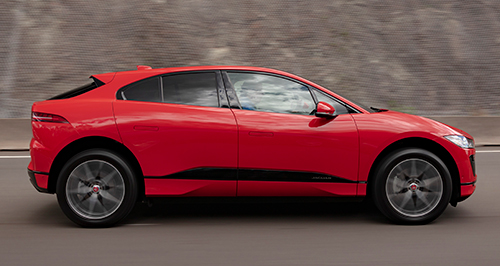News - JaguarJaguar working on subsidised I-Pace charging dealMultiple charging solutions to put an end to range anxiety for Jaguar I-Pace buyers7 Dec 2018 JAGUAR Land Rover (JLR) Australia says it is working on providing buyers of its first battery-electric vehicle, the I-Pace mid-size SUV, with a subsidised public charging service, in an effort to combat range anxiety with several practical solutions.
Speaking to GoAuto this week at the I-Pace national media launch in Sydney, JLR Australia product public affairs manager James Scrimshaw said range anxiety is quickly becoming less of a factor, especially with the I-Pace, which has a claimed 470km range under the new World harmonised Light vehicle Test Procedure (WLTP) standard.
“There’s a few things which aren’t there yet but will be different in 12 months’ time,” he said.
“The charging network is not there and advertised on every single corner for everyone, so people will have to think about how it will work for me, and maybe it’s not the easiest decision.
“In most cases, if people have got the home solution – a JetCharge (wallbox) – it’s going to be 99 per cent of their issue (solved).”
JLR Australia has strengthened its relationship with local EV charging specialist JetCharge by recommending its 7kW AC Mini Plus single-outlet wallbox to I-Pace owners with appropriate off-street parking.
While it takes more than 10 hours to charge the I-Pace’s 90kWH lithium-ion battery pack from zero to 80 per cent – and twice as long to reach 100 per cent – this wallbox is “more than enough” for the average commuter that travels 40 to 80km per day, according to JLR Australia.
The wallbox charges three times faster than a 2.3kW AC domestic power outlet, with prices starting at $2280 (including the unit, installation and GST) for a detached house with a standard garage, while its cost for an apartment building with multiple carparks is higher.
JLR Australia says that compared to a Porsche Macan Turbo which consumes 8.9 litres of petrol per 100 kilometres on the WLTP combined cycle test, I-Pace owners save about $1500 a year if both vehicles travel 13,716km and off-peak electricity and fuel cost 15c per kWh and $1.61 per litre respectively. The I-Pace consumes 21.2kWh per 100km.
Destination (hotels and shopping centres) and journey (long-distance stop points) charging are also key to the I-Pace ownership experience, although Mr Scrimshaw reiterated that JLR Australia was launching its first BEV into a market with underdeveloped infrastructure.
“We’re coming in nice and early; there’s not a lot of landscape there, but people who are investing in it … there’s some good stuff out there,” he said.
With the I-Pace supporting two European-standard Type 2 plugs, AC and CCS Combo DC, it is already compatible with 150 public charging stations in Australia, although this is dwarfed by the number of refuelling stations nationally.
As reported, JetCharge partner ChargeFox is currently in the process of establishing a fast-charging network in Australia, with each of its stations to support power outputs of up to 350kW.
While the I-Pace only can only handle up to 100kW, its battery pack can be charged from zero to 80 per cent in about 40 minutes, while it takes twice as long to reach full capacity.
Using ChargeFox’s network, I-Pace owners will be charged 30c per kWh – the equivalent of $5.70 for every 100km driven, which is about a third of the cost of an alternative petrol vehicle.
When asked if JLR Australia would eventually provide a subsidised charging service to I-Pace owners via its close relationship with ChargeFox, Mr Scrimshaw said: “We’d like to have it as part of the package, but that’s being worked out right now.
“We are working with them on a plan, and there are other car manufacturers that are talking to them, as well.
“At this point in time, the agreements have not been finalised between ChargeFox and the manufacturers, so we can’t tell you what ChargeFox is going to do, because that’s their business at the moment.
“We hope to announce the relationship, and what it means to the customer, soon.”
Such a move would be similar to Tesla Australia’s Supercharger network, which costs members 35c per kWh to use and can charge the I-Pace-rivalling Model X’s battery pack from zero to 80 per cent in about 30 minutes.  Read more6th of December 2018  Driven: Jaguar finds strong demand for I-Pace SUVJaguar looks beyond Tesla’s Model X and casts a wider net with its first I-Pace BEV22nd of August 2018  Jaguar to offer five-year warranty on I-Pace SUVFive-year/200,000km warranty for I-Pace EV resets Jaguar standard29th of March 2018  I-Pace electric SUV to change Jaguar brand perceptionsJaguar shedding old, stuffy image thanks to models such as I-Pace and E-Pace SUVs |
Click to shareJaguar articlesResearch Jaguar Motor industry news |















Facebook Twitter Instagram